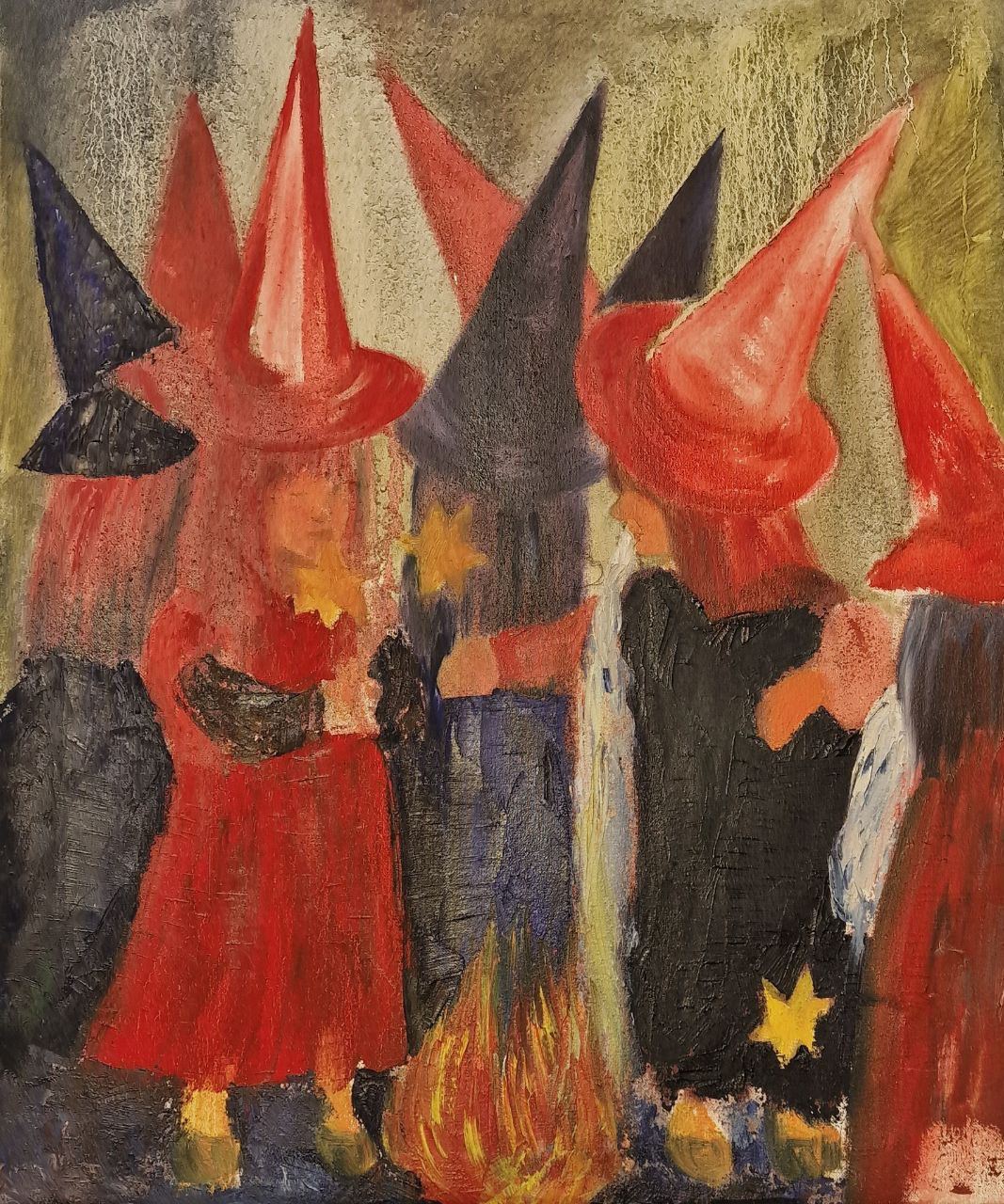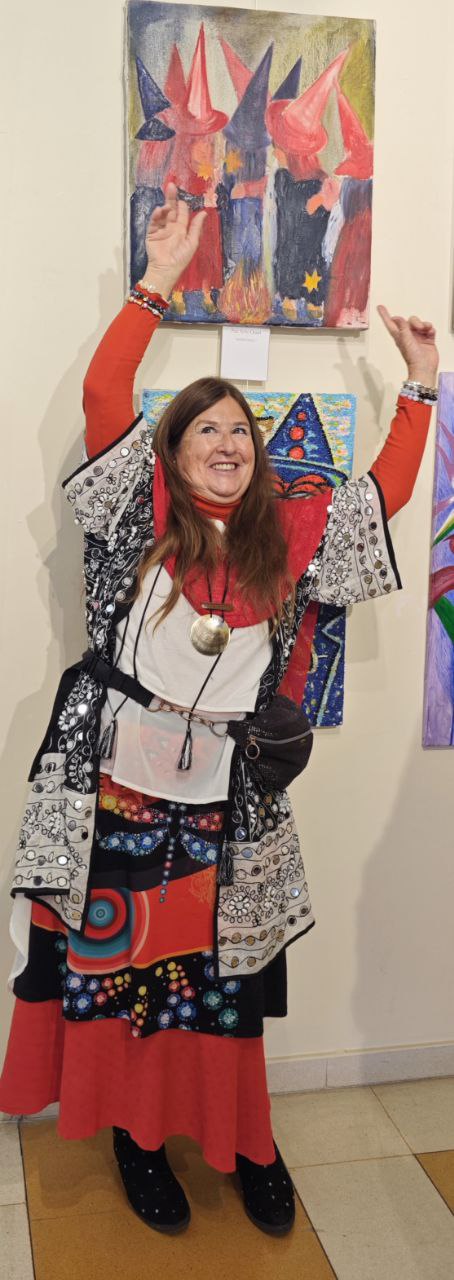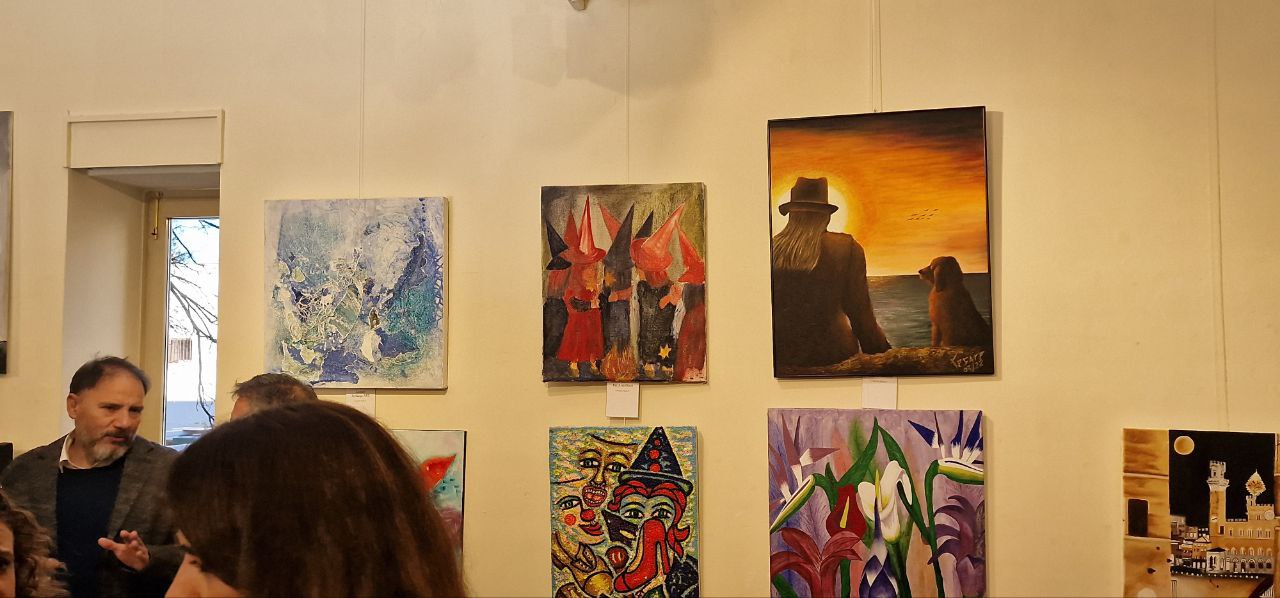Description
Descripción
Descrizione
描述
وصف
"The Little Magicians", a masterpiece by Paz Arés Osset, captures the mystical essence of childhood, where
the line
between play and reality fades into the air charged with the magic of an eternal carnival. Inspired by the
costume
plays and limitless imagination of her students at the Virgen del Retamar school where Paz was a teacher for
many
years, Arés Osset breathes life into every brushstroke, creating a world where children's fantasy becomes
tangible, a
place where wizard hats are not mere fabric but powerful conduits of the purest magic.
The enigmatic figures, shrouded in the cloak of night, gather around a fire that burns with the force of the
stars
themselves, materializing wishes in every spark that escapes into the sky. The work speaks of a parallel
universe
governed by the rules of the heart and imagination, where children, as little alchemists, have the power to
transform
the world with their games and dreams.
Arés Osset reminds us with "The Little Magicians" that magic, that force that seems so distant in our adult
daily
life, is a tangible reality in the world of children. In their hands, wands and hats become tools of
transformation,
and what they wish with the innocence of their hearts manifests before their astonished eyes. The artist
captures a
captivating warning: games and desires are not mere pastimes, but powerful acts of creation that must be
approached
with the same reverence with which a magician pronounces his spells.
"The Little Magicians" is not only a visually impressive representation of alchemy and fantasy, but also a
poignant
reminder that we must embrace and care for the imagination of children, for in it lies the power to shape the
future.
In this work, Paz Arés Osset not only teaches us that magic is real, but also urges us to question what kind
of
reality we are wishing for through the games we play and the fantasies we nourish.
Through the gaze of Paz Arés Osset, we are urged to play again, to dream with the carefreeness of youth, but
with the
wisdom of experience. Because by doing so, we not only reclaim our creative alchemical power, but also take
responsibility for the reality that our play can, and indeed, will create. In the bold palette and brave
strokes of
"The Little Magicians", Arés Osset not only captures an image; she captures a truth: that play is the first
language
of change, and that our most sincere games and desires have the power to weave the very fabric of the cosmos.
The work presents a fascinating conglomerate of figures that evoke the timelessness of magical narrative and
mystery.
These characters, dressed in conical hats reminiscent of the classic sorcerers of stories, are immersed in a
space
where color and form merge into a dynamic visual dialogue.
The viewer might observe that the chosen color palette is bold, with vibrant reds and deep blacks suggesting a
dance
between passion and the hidden. The application of the paint, with its palpable texture and almost impulsive
execution, speaks of a creative fervor that refuses to be contained. The presence of a fire element, along
with
scattered stars from the magic wands, adds a dimension of ritual and cosmology.
The work conveys a sense of movement and latent energy. There is a sense of community and secrecy among the
figures,
as if they were conspiring or participating in an ancient ritual. The viewer might feel that this piece is a
window
into a world where the archaic and the mystical intertwine, a world that invites exploration not only with the
eyes
but with the soul.
Ultimately, the viewer might conclude that the artist has successfully captured the essence of a magical
encounter,
one that awakens in the viewer a curiosity for untold stories and barely veiled secrets. The work is a
testament to
the ability to provoke emotion and reflection, challenging the viewer to immerse themselves in the feelings
that such
images evoke.
"Los Pequeños Magos", una obra maestra de Paz Arés Osset, captura la esencia mística de la infancia, donde la
línea
entre juego y realidad se desvanece en el aire cargado de la magia de un carnaval eterno. Inspirada por los
juegos de
disfraces y la ilimitada imaginación de sus alumnos en el colegio Virgen del Retamar donde Paz fue maestra por
muchos
años, Arés Osset infunde vida en cada pincelada, creando un mundo donde la fantasía infantil se torna
palpable, un lugar
donde los sombreros de brujo no son simples telas, sino poderosos conductos de la magia más pura.
Las figuras enigmáticas, envueltas en el manto de la noche, se reúnen alrededor de un fuego que arde con la
fuerza de
las estrellas mismas, materializando deseos en cada chispa que se escapa al cielo. La obra habla de un
universo paralelo
regido por las reglas del corazón y la imaginación, donde los niños, como pequeños alquimistas, tienen el
poder de
transformar el mundo con sus juegos y sus sueños.
Arés Osset nos recuerda con "Los Pequeños Magos" que la magia, esa fuerza que parece tan lejana en nuestro día
a día
adulto, es una realidad tangible en el mundo de los niños. En sus manos, varitas y sombreros se convierten en
herramientas de transformación, y lo que desean con la inocencia de sus corazones se manifiesta ante sus ojos
asombrados. La artista plasma una cautivadora advertencia: los juegos y los deseos no son meros pasatiempos,
sino actos
de creación poderosos que deben ser abordados con la misma reverencia con la que un mago pronuncia sus
encantamientos.
"Los Pequeños Magos" no solo es una representación visualmente impresionante de la alquimia y la fantasía,
sino un
recordatorio conmovedor de que debemos abrazar y cuidar la imaginación de los niños, pues en ella yace el
poder de
moldear el futuro. En esta obra, Paz Arés Osset no solo nos enseña que la magia es real, sino que también nos
impulsa a
preguntarnos qué clase de realidad estamos deseando a través de los juegos que jugamos y las fantasías que
alimentamos.
A través de la mirada de Paz Arés Osset, se nos insta a jugar de nuevo, a soñar con la despreocupación de la
juventud,
pero con la sabiduría de la experiencia. Porque al hacerlo, no solo recuperamos nuestro poder alquímico
creativo, sino
que también nos hacemos responsables de la realidad que nuestro juego puede, y de hecho, creará. En la audaz
paleta y
los trazos valientes de "Los Pequeños Magos" Arés Osset no sólo captura una imagen; ella captura una verdad:
que el
juego es la primera lengua del cambio, y que nuestros juegos y deseos más sinceros tienen el poder de tejer el
tejido
mismo del cosmos.
La obra presenta un fascinante conglomerado de figuras que evocan la atemporalidad de la narrativa mágica y el
misterio.
Estos personajes, ataviados con sombreros cónicos que recuerdan a los clásicos hechiceros de los cuentos,
están sumidos
en un espacio donde el color y la forma se funden en un diálogo visual dinámico.
El espectador podría observar que la paleta de colores escogida es audaz, con rojos vibrantes y negros
profundos que
sugieren una danza entre la pasión y lo oculto. La aplicación de la pintura, con su textura palpable y su
ejecución casi
impulsiva, habla de un fervor creativo que rehúsa ser contenido. La presencia de un elemento fuego, junto con
estrellas
dispersas de las varitas mágicas, aporta una dimensión de ritual y cosmología.
La obra transmite una sensación de movimiento y energía latente. Hay un sentido de comunidad y secretismo
entre las
figuras, como si estuvieran conspirando o participando en un antiguo ritual. El espectador podría sentir que
esta pieza
es una ventana a un mundo donde lo arcaico y lo místico se entrelazan, un mundo que invita a ser explorado no
sólo con
la vista, sino con el alma.
En última instancia, el espectador podría concluir que la artista ha capturado con éxito la esencia de un
encuentro
mágico, uno que despierta en el espectador la curiosidad por las historias no contadas y los secretos apenas
velados. La
obra es un testamento a la habilidad de provocar emoción y reflexión, desafiando al espectador a sumergirse en
los
sentimientos que tales imágenes evocan.
"I Piccoli Maghi", un capolavoro di Paz Arés Osset, cattura l'essenza mistica dell'infanzia, dove la linea
tra gioco
e realtà si dissolve nell'aria carica di magia di un carnevale eterno. Ispirata dai giochi di travestimento e
dall'immaginazione illimitata dei suoi studenti alla scuola Virgen del Retamar dove Paz è stata insegnante per
molti
anni, Arés Osset insuffla vita in ogni pennellata, creando un mondo dove la fantasia infantile diventa
tangibile, un
luogo dove i cappelli da stregone non sono semplici tessuti, ma potenti conduttori della magia più pura.
Le figure enigmatiche, avvolte nel manto della notte, si radunano attorno a un fuoco che brucia con la forza
delle
stesse stelle, materializzando desideri in ogni scintilla che sfugge verso il cielo. L'opera parla di un
universo
parallelo governato dalle regole del cuore e dell'immaginazione, dove i bambini, come piccoli alchimisti,
hanno il
potere di trasformare il mondo con i loro giochi e sogni.
Arés Osset ci ricorda con "I Piccoli Maghi" che la magia, quella forza che sembra così lontana nella nostra
vita
quotidiana da adulti, è una realtà tangibile nel mondo dei bambini. Nelle loro mani, bacchette e cappelli
diventano
strumenti di trasformazione, e ciò che desiderano con l'innocenza dei loro cuori si manifesta davanti ai loro
occhi
stupiti. L'artista cattura un avvertimento affascinante: i giochi e i desideri non sono semplici passatempi,
ma
potenti atti di creazione che devono essere affrontati con la stessa riverenza con cui un mago pronuncia i
suoi
incantesimi.
"I Piccoli Maghi" non è solo una rappresentazione visivamente impressionante dell'alchimia e della fantasia,
ma anche
un commovente promemoria che dobbiamo abbracciare e curare l'immaginazione dei bambini, poiché in essa risiede
il
potere di plasmare il futuro. In quest'opera, Paz Arés Osset non solo ci insegna che la magia è reale, ma ci
spinge
anche a interrogarci su quale tipo di realtà stiamo desiderando attraverso i giochi che giochiamo e le
fantasie che
nutriamo.
Attraverso lo sguardo di Paz Arés Osset, siamo incoraggiati a giocare di nuovo, a sognare con la
spensieratezza della
gioventù, ma con la saggezza dell'esperienza. Perché facendolo, non solo recuperiamo il nostro potere
alchemico
creativo, ma assumiamo anche la responsabilità della realtà che il nostro gioco può, e di fatto, creerà. Nella
palette
audace e nelle pennellate coraggiose de "I Piccoli Maghi", Arés Osset non solo cattura un'immagine; cattura
una
verità: che il gioco è la prima lingua del cambiamento, e che i nostri giochi e desideri più sinceri hanno il
potere
di tessere il tessuto stesso del cosmo.
L'opera presenta un affascinante conglomerato di figure che evocano l'atemporalità della narrativa magica e
del
mistero. Questi personaggi, vestiti con cappelli conici che ricordano i classici stregoni delle storie, sono
immersi
in uno spazio dove il colore e la forma si fondono in un dialogo visivo dinamico.
Lo spettatore potrebbe osservare che la palette di colori scelta è audace, con rossi vibranti e neri profondi
che
suggeriscono una danza tra la passione e l'occulto. L'applicazione della pittura, con la sua texture palpabile
e la
sua esecuzione quasi impulsiva, parla di un fervore creativo che rifiuta di essere contenuto. La presenza di
un
elemento fuoco, insieme a stelle sparse dalle bacchette magiche, aggiunge una dimensione di rituale e
cosmologia.
L'opera trasmette una sensazione di movimento ed energia latente. C'è un senso di comunità e segretezza tra le
figure,
come se stessero cospirando o partecipando a un antico rituale. Lo spettatore potrebbe sentire che questo
pezzo è una
finestra su un mondo dove l'arcaico e il mistico si intrecciano, un mondo che invita ad essere esplorato non
solo con
gli occhi, ma con l'anima.
In definitiva, lo spettatore potrebbe concludere che l'artista è riuscita a catturare con successo l'essenza
di un
incontro magico, uno che risveglia nello spettatore la curiosità per storie non raccontate e segreti appena
velati.
L'opera è una testimonianza della capacità di provocare emozione e riflessione, sfidando lo spettatore a
immergersi
nei sentimenti che tali immagini evocano.
《小魔术师》, Paz Arés Osset 的杰作,捕捉了童年的神秘本质,游戏和现实之间的界限在永恒狂欢的魔法空气中消散。受到她在 Virgen del Retamar 学校学生们的换装游戏和无限想象力的启发,其中
Paz
曾是多年的教师,Arés Osset 为每一笔触赋予了生命,创造了一个孩童的幻想变得有形的世界,一个巫师帽不仅仅是布料,而是最纯粹魔法的强大渠道的地方。
神秘的人物,在夜晚的斗篷中,围绕着一个有着星辰般力量的火焰聚集,每一个逃逸到天空的火花都实现了一个愿望。这幅作品讲述了一个由心灵和想象力统治的平行宇宙,孩子们就像小炼金术士,拥有着用游戏和梦想改变世界的力量。
Arés Osset
通过《小魔术师》提醒我们,魔法这种在我们成年人日常生活中似乎遥远的力量,在孩子们的世界中是一个有形的现实。在他们手中,魔杖和帽子成为了转化的工具,他们用心中的纯真愿望所希望的,都在他们惊讶的眼前显现。这位艺术家传达了一个迷人的警告:游戏和愿望不仅仅是消遣,而是必须以同魔法师念咒时的敬畏来对待的强大创造行为。
《小魔术师》不仅仅是炼金术和幻想的视觉上令人印象深刻的表现,也是一个感人的提醒,我们必须拥抱并关怀孩子们的想象力,因为在其中蕴含着塑造未来的力量。在这幅作品中,Paz Arés Osset
不仅教导我们魔法是真实的,也促使我们去质疑我们通过玩耍的游戏和我们所滋养的幻想所期望的那种现实。
通过 Paz Arés Osset
的视角,我们被鼓励再次玩耍,像年轻时那样无忧无虑地梦想,但带着经验的智慧。因为这样做,我们不仅重新获得了我们的创造性炼金术力量,也承担了我们的游戏实际上可以创造的现实的责任。在《小魔术师》大胆的色彩和勇敢的笔触中,Arés
Osset
不仅捕捉到了一个图像;她捕捉到了一个真理:游戏是改变的第一种语言,我们最真诚的游戏和愿望有能力编织宇宙的本质。
这幅作品呈现了一个迷人的人物集合,唤起了神奇叙事和神秘的永恒感。这些角色,身着让人想起故事中经典巫师的尖顶帽,沉浸在颜色和形式融合成动态视觉对话的空间中。
观众可能会注意到选择的色彩板是大胆的,充满活力的红色和深邃的黑色暗示着激情与隐藏之间的舞蹈。画面的涂抹,其有形的质地和几乎冲动的执行,讲述了一种拒绝被束缚的创造热情。火元素的存在,加上从魔法棒中散落的星星,增添了一种仪式和宇宙学的维度。
这幅作品传达了一种运动感和潜在的能量。这些人物之间有一种社区感和秘密感,就像他们在密谋或参与一个古老的仪式。观众可能会感觉到这件作品是通往一个古老与神秘交织在一起的世界的窗口,一个邀请不仅用眼睛,而且用灵魂去探索的世界。
最终,观众可能会得出结论,艺术家成功捕捉了一个魔幻的相遇的本质,一个在观众中唤醒对未被讲述的故事和刚刚掩盖的秘密的好奇心。这幅作品是引发情感和反思能力的证明,挑战观众沉浸在这些图像所唤起的感受中。
"السحرة الصغار"، تحفة فنية لباز أريس أوسيت، تلتقط جوهر الطفولة السحري، حيث تتلاشى الخطوط بين اللعب والواقع في
الهواء
المشحون بسحر كرنفال أبدي. مستوحاة من ألعاب التنكر والخيال اللامحدود لطلابها في مدرسة فيرجن ديل ريتامار، حيث
كانت باز
معلمة لسنوات عديدة، تنفث أريس أوسيت الحياة في كل ضربة فرشاة، مبتكرةً عالمًا يصبح فيه الخيال الطفولي ملموسًا،
مكانًا
يتحول فيه قبعات الساحرة ليست مجرد أقمشة بل قنوات قوية لأنقى أشكال السحر.
تتجمع الشخصيات الغامضة، متوشحةً برداء الليل، حول نار تحترق بقوة النجوم نفسها، تحقق الأمنيات في كل شرارة تتطاير
نحو
السماء. تتحدث العمل عن عالم موازٍ يحكمه قوانين القلب والخيال، حيث يمتلك الأطفال، كالكيميائيين الصغار، القدرة
على تحويل
العالم بألعابهم وأحلامهم.
تذكرنا أريس أوسيت في "السحرة الصغار" بأن السحر، تلك القوة التي تبدو بعيدة في حياتنا اليومية كبالغين، هي حقيقة
ملموسة
في عالم الأطفال. في أيديهم، تتحول العصي والقبعات إلى أدوات للتحول، وما يتمنونه ببراءة قلوبهم يتجسد أمام أعينهم
المتعجبة. تسجل الفنانة تحذيرًا جذابًا: الألعاب والأمنيات ليست مجرد تسلية، بل أعمال خلق قوية يجب التعامل معها
بنفس
الإجلال الذي ينطق به الساحر تعاويذه.
"السحرة الصغار" ليست مجرد تمثيل مرئي مثير للإعجاب للكيمياء والخيال، بل هي تذكير مؤثر بأننا يجب أن نحتضن ونهتم
بخيال
الأطفال، لأن في ذلك يكمن القدرة على تشكيل المستقبل. في هذا العمل، لا تعلمنا باز أريس أوسيت فقط أن السحر حقيقي،
بل
تحثنا أيضًا على التساؤل عن نوع الواقع الذي نتمناه من خلال الألعاب التي نلعبها والخيالات التي نغذيها.
من خلال نظرة باز أريس أوسيت، نحث على اللعب مرة أخرى، والحلم بلا مبالاة الشباب، ولكن بحكمة التجربة. لأننا بذلك،
لا
نستعيد فقط قوتنا الكيميائية الإبداعية، بل نتحمل أيضًا المسؤولية عن الواقع الذي يمكن للعبنا أن يخلقه، وفعلاً
سيخلقه. في
اللوحة الجريئة والضربات الشجاعة لـ"السحرة الصغار"، لا تلتقط أريس أوسيت صورة فحسب، بل تلتقط حقيقة: أن اللعب هو
لغة
التغيير الأولى، وأن ألعابنا وأمنياتنا الأكثر صدقًا لها القدرة على نسج نسيج الكون نفسه.
تعرض اللوحة تجمعًا ساحرًا للشخصيات التي تستحضر الخلود السردي للسحر والغموض. هذه الشخصيات، مرتدية قبعات مخروطية
تذكرنا
بالسحرة الكلاسيكيين من القصص، غارقة في فضاء يتمازج فيه اللون والشكل في حوار بصري ديناميكي.
قد يلاحظ المشاهد أن لوحة الألوان المختارة جريئة، مع أحمر نابض بالحياة وأسود عميق يوحي برقصة بين الشغف والخفي.
تطبيق
الطلاء، بملمسه الملموس وتنفيذه شبه الاندفاعي، يتحدث عن حماسة إبداعية ترفض أن تكون محتواة. وجود عنصر النار، إلى
جانب
النجوم المتناثرة من العصي السحرية، يضيف بُعدًا للطقوس وعلم الكونيات.
تنقل العمل شعورًا بالحركة والطاقة الكامنة. هناك شعور بالمجتمع والسرية بين الشخصيات، كما لو أنهم يتآمرون أو
يشاركون في
طقوس قديمة. قد يشعر المشاهد أن هذه القطعة نافذة على عالم يتشابك فيه القديم والغامض، عالم يدعو للاستكشاف ليس
فقط
بالعين، بل بالروح.
في النهاية، قد يخلص المشاهد إلى أن الفنانة قد نجحت بجدارة في التقاط جوهر لقاء سحري، لقاء يُوقظ في المشاهد
الفضول
لاكتشاف الحكايات غير المروية والأسرار المكتنزة. العمل هو شهادة على القدرة على استثارة العاطفة والتفكير،
متحدياً
المشاهد للغوص في الأحاسيس التي تثيرها هذه الصور.





